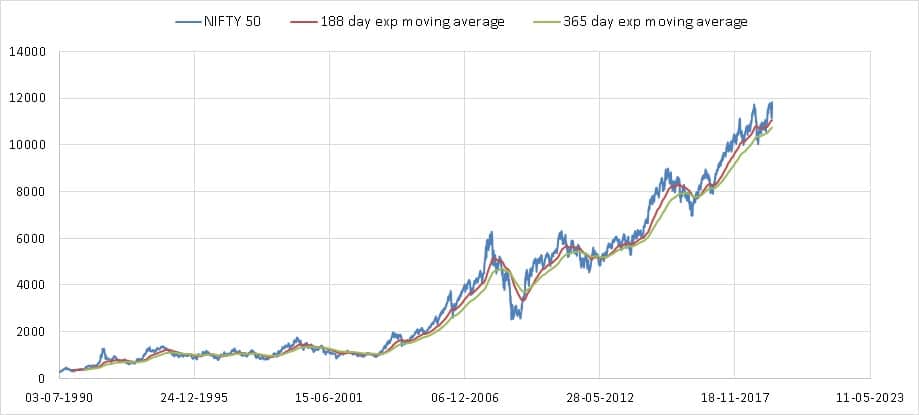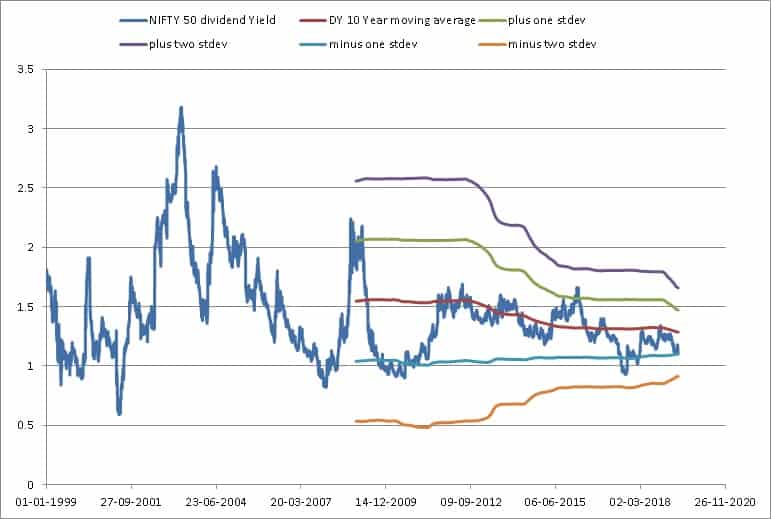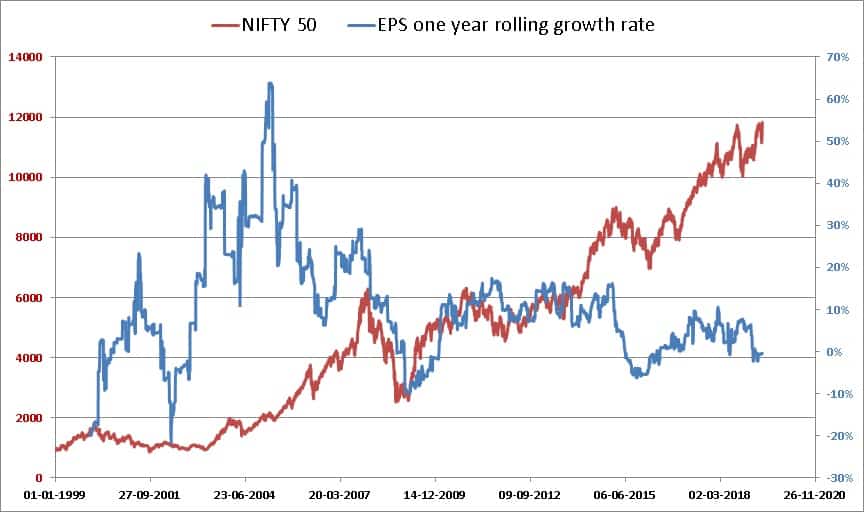Last Updated on December 7, 2022 at 9:58 pm
Use this nifty valuation tool to find out if the stock market is expensive or cheap using PE, PB, Div Yield, Bollinger Bands and much more. The idea to try and understand the state of the market using multiple methods. An example of some of the results obtained with this sheet is here: Are we now in a bear market?
Four different types of indicators can be used: Trend, volatility, momentum, and valuation. The sheet can be used for periodic profit booking or market timing or tactical asset allocation. It can also be used for buying on dips, but I would recommend reading this first: Buying on market dips: How effective is it?
Disclaimer: The sheet provided below is informational/education in nature. It will tell you the results of various indicators, but will not tell you when to buy or sell or do anything. That judgment is entirely up to the user. The sheet has been extensively tested for bugs and there are no known bugs at this time of release. However, it is not possible to guarantee that the sheet is free of errors. Users can bring issues to my notice for evaluation. I am not responsible for gains or losses that the user may suffer by using this tool
Many investors sit and fret if the market is overvalued and if this is the right time to invest or not. This sheet can provide quantitative insight into the state of the market. Instead of looking at only the PE or a moving average, it would be better if different types of indicators are used to check stock market valuation. Sometimes multiple indicators may agree with each other and sometimes no. During such times the user will have to use their discretion and judgment. We shall look at examples of each indicator type available and how to interpret them.
Join 32,000+ readers and get free money management solutions delivered to your inbox! Subscribe to get posts via email! (Link takes you to our email sign-up form)
🔥Want to create a complete financial plan? Learn goal-based investing? Exclusive access to our DIY tools? Increase your income with your skills? Use this link to enjoy massive discounts on our robo-advisory tool & courses! 🔥
Nifty Valuation Tool: List of indicators available
Indicator Type: Trend
- Simple moving average (180 and 365 days, the duration can be set by user)
- Exponential moving average (180 and 365 days, the duration can be set by user)
- Moving Average Convergence Divergence (MACD)
Indicator Type: Volatility (plus trend)
- Bollinger bands with 200 days DMA
Indicator type: momentum
- Relative Strength Indicator
Indicator type: Valuation
- Price to earnings ratio (PE) with 10-year moving average and standard deviation bands
- Price to book value (PB) with 10-year moving average and standard deviation bands
- Dividend Yield with 10-year moving average and standard deviation bands
- EPS Growth rate
- ROE or book yield
Simple moving average
Stock market price movements on a daily basis are too noisy. So to spot trends, we need to smoothen them. One can take the average of the last 200 day prices for this. To spot bullish and bearish trends, a double moving average is used: One for about 180 days (6 months) and another for about 365 days (12 months).
Sometimes the period would be 180 days or 179 days or 181 days depending on the index used. Here is an example:
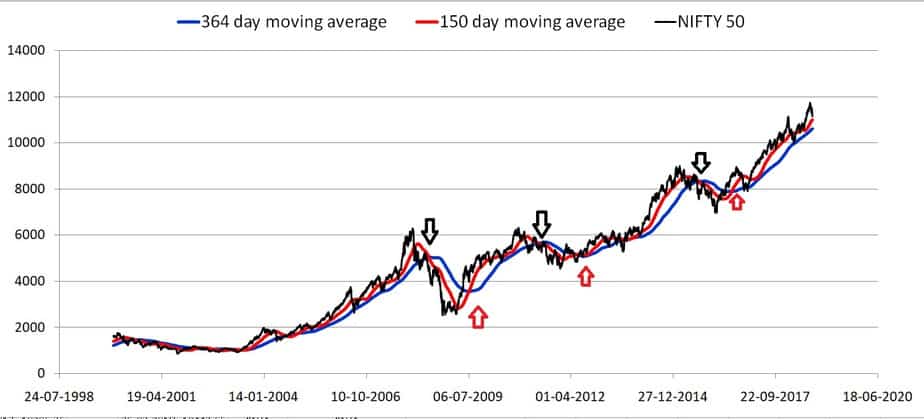
A bearish trend is possible when the 150-day average falls below the 364-day average- downward arrows. A bullish trend is possible when the 150-day average moves above the 364-day average – upward red arrows.
The problem is, sometimes both these averages will cross each other in quick succession (see below) a problem known as whipsaw. To prevent this, we use the exponential moving average
 Exponential Moving Average
Exponential Moving Average
The standard alternative to the simple moving average (SMA, also known as daily moving average or DMA) is the exponential moving average. (EMA) This offers higher weight to recent price movement and responds faster than the simple moving average as seen below. The weight to older data decreases exponentially and hence responds faster.
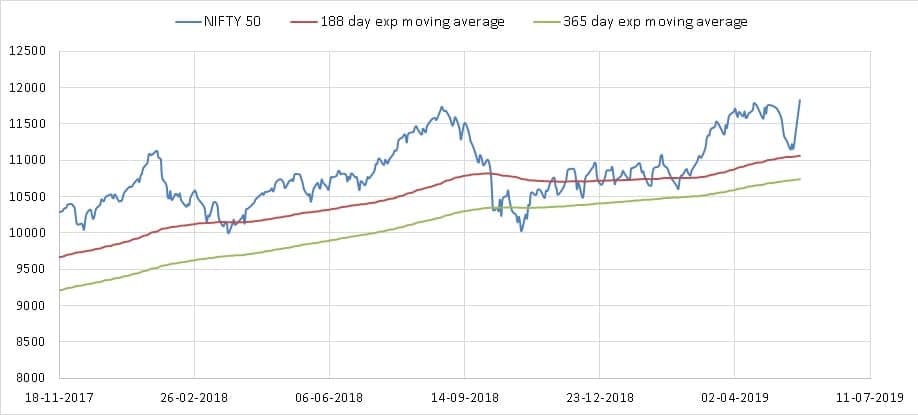 If we go by the double EMAs, the market has been bullish for a while now.
If we go by the double EMAs, the market has been bullish for a while now.
Moving Average Convergence Divergence (MACD)
A potentially more sensitive method is to compute the difference between the two EMAs above and then take the moving average of the difference. The MACD seen below is the difference between the 188-day EMA and 365-day EMA. The average of this difference is known as the MACD signal or simply the signal. I have used a 136-day average.
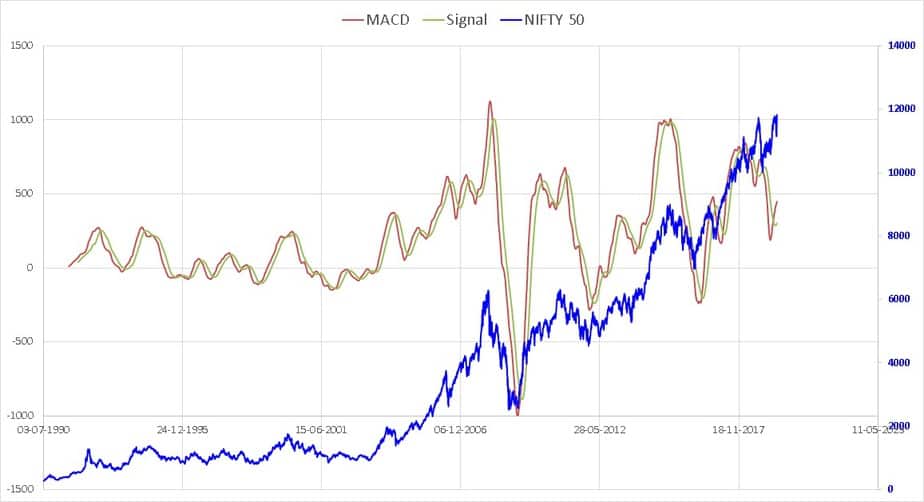 Down-trend: When the MACD goes below its signal.
Down-trend: When the MACD goes below its signal.
Bollinger Bands
This technique helps us make better decisions with the 200-day moving average and also gives us insights on market volatility. Bollinger bands are essentially rolling standard deviation bands for the 200 DMA. The upper band is usually set two standard deviations above the 200 DMA and the lower band set at two below.
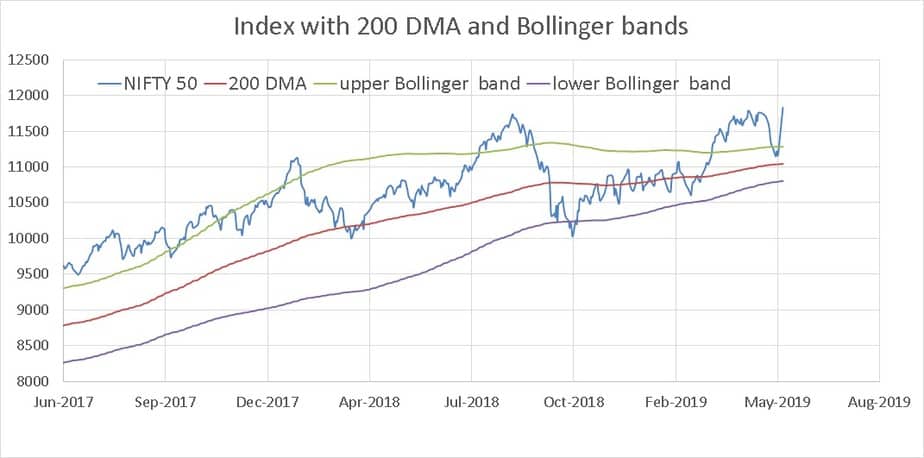 Volatility indication When the upper and lower bands converge with the 200dma moving up, it could mean bullish trend. When the upper and lower bands converge with the 200dm a moving down, then it could indicate a bearish trend.
Volatility indication When the upper and lower bands converge with the 200dma moving up, it could mean bullish trend. When the upper and lower bands converge with the 200dm a moving down, then it could indicate a bearish trend.
You can spot both a bullish trend (200 DMA above the upper band) and the bands coming together (decrease in volatility). that does not happen often!!
Buy/sell indication With the bands reasonably spaced apart, if the price hits the upper band, it could mean an overheated market and a sell indication. That is a bearish market outlook. With the bands spaced reasonably apart, if the price hits the lower band, it could mean a buy indication.
Relative strength indicator
The simplest definition of the RSI is that it represents recent average gains divided by average losses. If the avg gains are higher than the index is overbought. If the avg losses are higher, the index is oversold. The problem with the RSI is similar to that of the PE or PB ratios. It is based on arbitrary high or low numbers. I have plotted the 365-day RSI for the Nifty below. It is more useful as a buy indicator than a sell indicator.
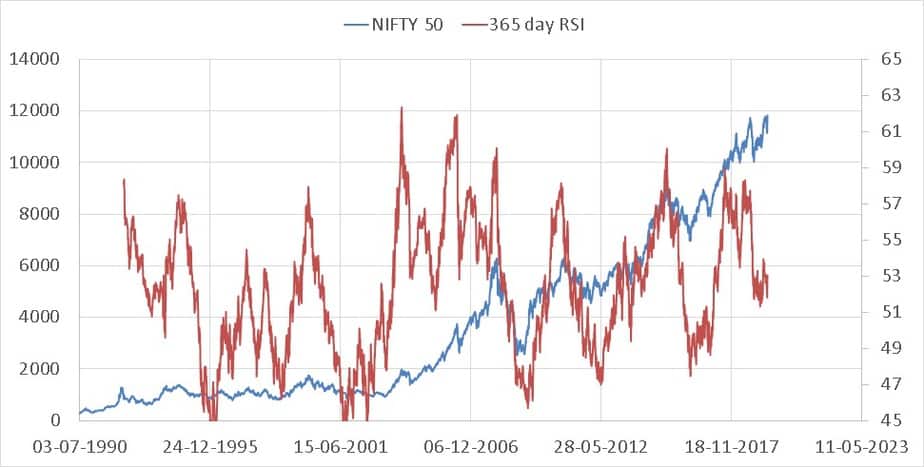 A low RSI value is a reasonable buy indicator. Current values are not too high.
A low RSI value is a reasonable buy indicator. Current values are not too high.
Nifty PE Valuation
The PE ratio is the current price divided by the earnings per share of the index. If the PE is “too high” then the market is paying too high a price for the earnings and must “correct” down (I hate that word now!). If the PE is “too low” then the market is paying too low a price and must correct up.
Have a look at the 10-year moving average (avg) of the Nifty 50 PE (the center line below). The standard deviation (stdev) tells you how much each Nifty PE value deviates from the average. The two lines above the central average line represent:
- avg + stdev
- avg + 2*stdev
Similarly, the two lines below the central average line represent:
- avg – stdev
- avg – 2*stdev
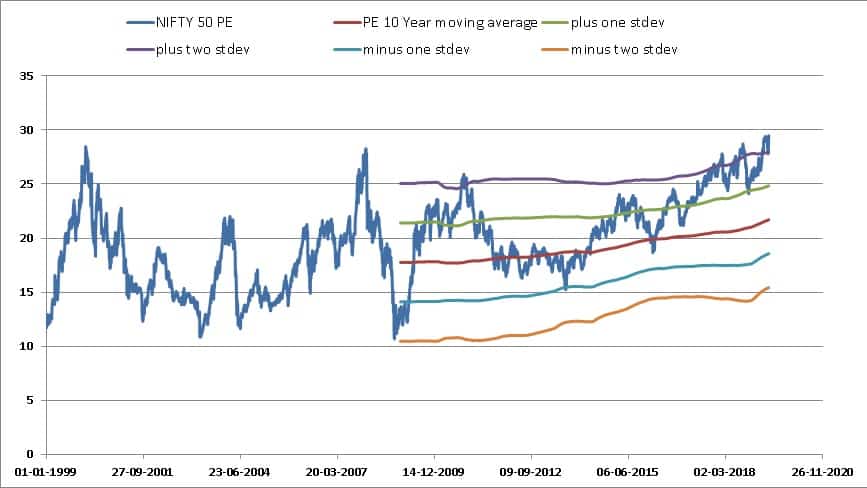 Typically when the current Nifty PE hits the +2 stdev line, it tends to come down (this is NOT mean reversion!), but the problem is, it need not come down too much!! So Current PE > + 2 stdev does not mean a crash!!
Typically when the current Nifty PE hits the +2 stdev line, it tends to come down (this is NOT mean reversion!), but the problem is, it need not come down too much!! So Current PE > + 2 stdev does not mean a crash!!
Nifty PB Valuation
Arguments made above can also be used to gauge valuation using the price to book value. The book value or shareholders is a measure of asset assets – liabilities. So it is a bit like the NAV of an ETF and the current market price the price of the ETF.
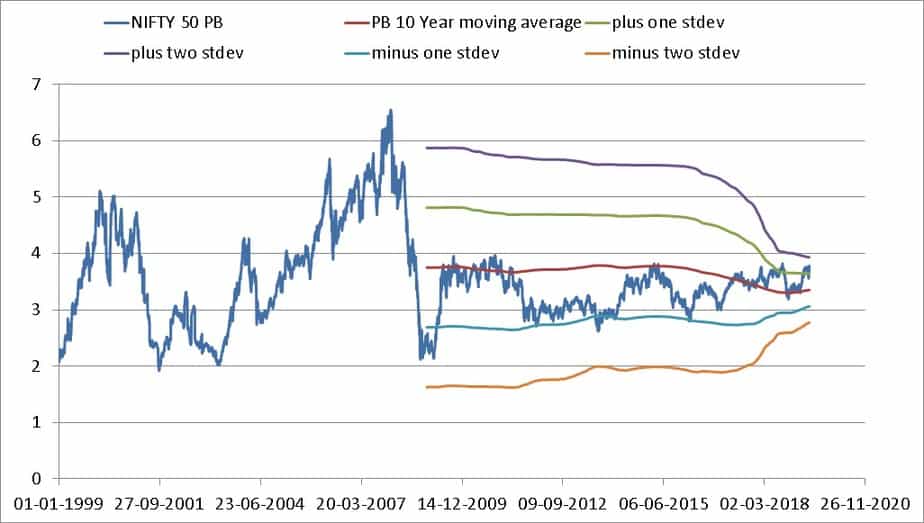 Again, a high PB could mean a “correction” and low PB, time to buy. A conservative market timer could use PB instead of PE.
Again, a high PB could mean a “correction” and low PB, time to buy. A conservative market timer could use PB instead of PE.
Dividend Yield
The dividend yield is a contra-indicator. That is a low value could mean over-valuation and vice-versa. The dividend yield of a single stock is computed as the most recent dividend* / current price. A high dividend yield implies the stock price has moved up faster than its dividend and vice versa. Hence low div yield of the index points to overvaluation and vice versa. Current Nifty Dividend Yield is fairly low indicating overvaluation.
* Sometime multiplied by 4 to annualize it.
EPS one-year growth rate
Earnings per share = Price/PE. The one-year growth in the EPS is shown below. in 2002, a sudden drop in interest rates triggered the EPS growth rate and a bull run. Notice that in recent years, there is virtually an absence of EPS growth. This is why I mentioned Do not start dreaming of a bull run even IF exit polls are right!! A bull run accompanied by an increase in EPS growth rate is a healthy bull run.
ROE or Book Yield
PB divided by the PE gives Earnings per share divided by book value per share. This is also known as return on equity or book yield. This is a profitability measure. Unfortunately, this has been moving south. Again, an increase in price accompanied by an increase in ROE is a healthy bull run.
 Nifty Valuation Tool Instructions Page
Nifty Valuation Tool Instructions Page
The user following the instructions in this page can paste any index data (price, PE, PB, Div Yield) and analyze valuation. Automated data download is not possible/feasible.
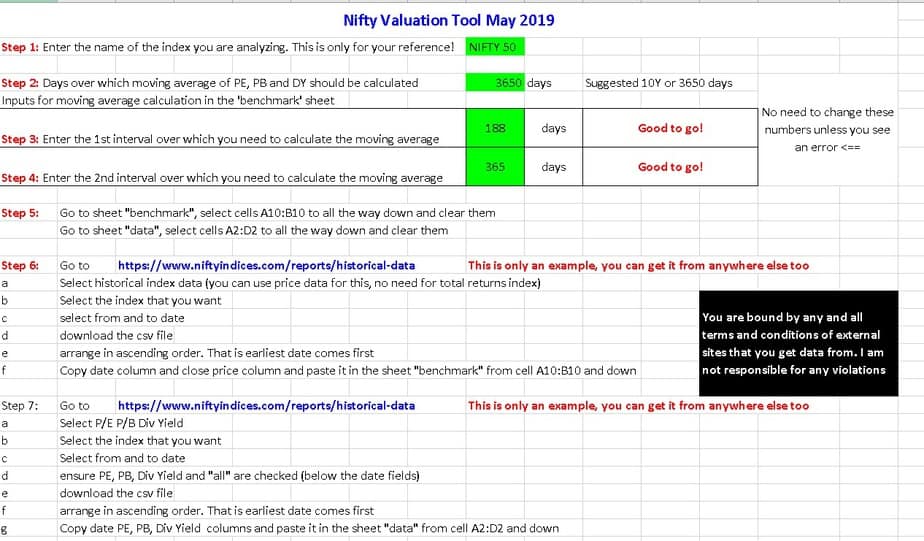 Disclaimer: The sheet provided below is informational/educational. It will tell you the results of various indicators but not when to buy, sell, or do anything else. That judgment is entirely up to the user. The sheet has been extensively tested for bugs, and there are no known bugs. However, it is impossible to guarantee that the sheet is free of errors. Users can bring issues to my notice for evaluation. I am not responsible for gains or losses that the user may suffer by using this tool.
Disclaimer: The sheet provided below is informational/educational. It will tell you the results of various indicators but not when to buy, sell, or do anything else. That judgment is entirely up to the user. The sheet has been extensively tested for bugs, and there are no known bugs. However, it is impossible to guarantee that the sheet is free of errors. Users can bring issues to my notice for evaluation. I am not responsible for gains or losses that the user may suffer by using this tool.
The Nifty Valuation tool is priced at Rs. 1000
You can also get Nifty PE Tool + Tactical Buy/Sell Tool as a combo deal for Rs. 1500.

Use our Robo-advisory Tool to create a complete financial plan! ⇐More than 3,000 investors and advisors use this! Use the discount code: robo25 for a 20% discount. Plan your retirement (early, normal, before, and after), as well as non-recurring financial goals (such as child education) and recurring financial goals (like holidays and appliance purchases). The tool would help anyone aged 18 to 80 plan for their retirement, as well as six other non-recurring financial goals and four recurring financial goals, with a detailed cash flow summary.
🔥You can also avail massive discounts on our courses and the freefincal investor circle! 🔥& join our community of 8000+ users!
Track your mutual funds and stock investments with this Google Sheet!
We also publish monthly equity mutual funds, debt and hybrid mutual funds, index funds, and ETF screeners, as well as momentum and low-volatility stock screeners.
You can follow our articles on Google News

We have over 1,000 videos on YouTube!

Join our WhatsApp Channel



- Do you have a comment about the above article? Reach out to us on Twitter: @freefincal or @pattufreefincal
- Have a question? Subscribe to our newsletter using the form below.
- Hit 'reply' to any email from us! We do not offer personalised investment advice. We can write a detailed article without mentioning your name if you have a generic question.
Join 32,000+ readers and get free money management solutions delivered to your inbox! Subscribe to get posts via email! (Link takes you to our email sign-up form)
About The Author
 Dr M. Pattabiraman (PhD) is the founder, managing editor and primary author of freefincal. He is an associate professor at the Indian Institute of Technology, Madras. He has over 13 years of experience publishing news analysis, research and financial product development. Connect with him via Twitter(X), LinkedIn, or YouTube. Pattabiraman has co-authored three print books: (1) You can be rich too with goal-based investing (CNBC TV18) for DIY investors. (2) Gamechanger for young earners. (3) Chinchu Gets a Superpower! for kids. He has also written seven other free e-books on various money management topics. He is a patron and co-founder of “Fee-only India,” an organisation promoting unbiased, commission-free, AUM-independent investment advice.
Dr M. Pattabiraman (PhD) is the founder, managing editor and primary author of freefincal. He is an associate professor at the Indian Institute of Technology, Madras. He has over 13 years of experience publishing news analysis, research and financial product development. Connect with him via Twitter(X), LinkedIn, or YouTube. Pattabiraman has co-authored three print books: (1) You can be rich too with goal-based investing (CNBC TV18) for DIY investors. (2) Gamechanger for young earners. (3) Chinchu Gets a Superpower! for kids. He has also written seven other free e-books on various money management topics. He is a patron and co-founder of “Fee-only India,” an organisation promoting unbiased, commission-free, AUM-independent investment advice.Our flagship course! Learn to manage your portfolio like a pro to achieve your goals regardless of market conditions! ⇐ More than 3,500 investors and advisors are part of our exclusive community! Get clarity on how to plan for your goals and achieve the necessary corpus no matter the market condition!! Watch the first lecture for free! One-time payment! No recurring fees! Life-long access to videos! Reduce fear, uncertainty and doubt while investing! Learn how to plan for your goals before and after retirement with confidence.
Increase your income by getting people to pay for your skills! ⇐ More than 800 salaried employees, entrepreneurs and financial advisors are part of our exclusive community! Learn how to get people to pay for your skills! Whether you are a professional or small business owner seeking more clients through online visibility, or a salaried individual looking for a side income or passive income, we will show you how to achieve this by showcasing your skills and building a community that trusts and pays you. (watch 1st lecture for free). One-time payment! No recurring fees! Life-long access to videos!
Our book for kids: “Chinchu Gets a Superpower!” is now available!


Must-read book even for adults! This is something that every parent should teach their kids right from their young age. The importance of money management and decision making based on their wants and needs. Very nicely written in simple terms. - Arun.Buy the book: Chinchu gets a superpower for your child!
How to profit from content writing: Our new ebook is for those interested in getting a side income via content writing. It is available at a 50% discount for Rs. 500 only!
Do you want to check if the market is overvalued or undervalued? Use our market valuation tool (it will work with any index!), or get the Tactical Buy/Sell timing tool!
We publish monthly mutual fund screeners and momentum, low-volatility stock screeners.
About freefincal & its content policy. Freefincal is a News Media organisation dedicated to providing original analysis, reports, reviews and insights on mutual funds, stocks, investing, retirement and personal finance developments. We do so without conflict of interest and bias. Follow us on Google News. Freefincal serves more than three million readers a year (5 million page views) with articles based only on factual information and detailed analysis by its authors. All statements made will be verified with credible and knowledgeable sources before publication. Freefincal does not publish paid articles, promotions, PR, satire or opinions without data. All opinions will be inferences backed by verifiable, reproducible evidence/data. Contact Information: To get in touch, please use our contact form. (Sponsored posts or paid collaborations will not be entertained.)
Connect with us on social media
- Twitter @freefincal
- Subscribe to our YouTube Videos
- Posts feed via Feedburner.
Our publications
You Can Be Rich Too with Goal-Based Investing
 Published by CNBC TV18, this book is designed to help you ask the right questions and find the correct answers. Additionally, it comes with nine online calculators, allowing you to create custom solutions tailored to your lifestyle. Get it now.
Published by CNBC TV18, this book is designed to help you ask the right questions and find the correct answers. Additionally, it comes with nine online calculators, allowing you to create custom solutions tailored to your lifestyle. Get it now.Gamechanger: Forget Startups, Join Corporate & Still Live the Rich Life You Want
 This book is designed for young earners to get their basics right from the start! It will also help you travel to exotic places at a low cost! Get it or gift it to a young earner.
This book is designed for young earners to get their basics right from the start! It will also help you travel to exotic places at a low cost! Get it or gift it to a young earner.Your Ultimate Guide to Travel
 This is an in-depth exploration of vacation planning, including finding affordable flights, budget accommodations, and practical travel tips. It also examines the benefits of travelling slowly, both financially and psychologically, with links to relevant web pages and guidance at every step. Get the PDF for Rs 300 (instant download)
This is an in-depth exploration of vacation planning, including finding affordable flights, budget accommodations, and practical travel tips. It also examines the benefits of travelling slowly, both financially and psychologically, with links to relevant web pages and guidance at every step. Get the PDF for Rs 300 (instant download)

